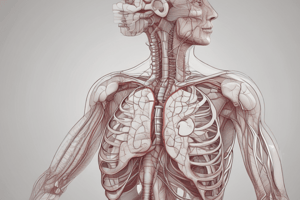Podcast
Questions and Answers
Where does cellular respiration occur in cells?
Where does cellular respiration occur in cells?
- Endoplasmic Reticulum
- Mitochondria (correct)
- Nucleus
- Golgi Apparatus
What is produced as a waste product during cellular respiration?
What is produced as a waste product during cellular respiration?
- Water
- Carbon Dioxide (correct)
- Glucose
- Oxygen
Where does deoxygenated blood return to through veins?
Where does deoxygenated blood return to through veins?
- Right Ventricle
- Left Atrium
- Pulmonary Arteries
- Right Atrium (correct)
What chamber pumps deoxygenated blood to the lungs?
What chamber pumps deoxygenated blood to the lungs?
What is a lower resting heart rate typically an indicator of?
What is a lower resting heart rate typically an indicator of?
What is the primary function of the circulatory and respiratory systems?
What is the primary function of the circulatory and respiratory systems?
What is the role of the lungs in the circulatory and respiratory systems?
What is the role of the lungs in the circulatory and respiratory systems?
Where do oxygen and glucose combine during cellular respiration?
Where do oxygen and glucose combine during cellular respiration?
What is energy used for in cells during cellular respiration?
What is energy used for in cells during cellular respiration?
What happens to carbon dioxide during gaseous exchange in the lungs?
What happens to carbon dioxide during gaseous exchange in the lungs?
What is the primary function of blood circulation?
What is the primary function of blood circulation?
Which chamber of the heart receives oxygen-rich blood from the lungs?
Which chamber of the heart receives oxygen-rich blood from the lungs?
What is the main artery that leaves the heart and distributes blood to the rest of the body?
What is the main artery that leaves the heart and distributes blood to the rest of the body?
What is the function of arteries in the circulatory system?
What is the function of arteries in the circulatory system?
What is the characteristic of capillaries in the circulatory system?
What is the characteristic of capillaries in the circulatory system?
What is the function of veins in the circulatory system?
What is the function of veins in the circulatory system?
What is the characteristic of veins in the circulatory system?
What is the characteristic of veins in the circulatory system?
Which of the following is true about the pulmonary veins?
Which of the following is true about the pulmonary veins?
What is the pathway of oxygenated blood from the lungs to the heart?
What is the pathway of oxygenated blood from the lungs to the heart?
What is the function of the heart in the circulatory system?
What is the function of the heart in the circulatory system?
Flashcards are hidden until you start studying
Study Notes
Circulation and Respiration
Blood Circulation from the Lungs to the Heart
- Oxygen-rich blood from the lungs travels through the pulmonary veins to the left atrium of the heart.
- The left atrium receives oxygen-rich blood from the lungs and pumps it into the left ventricle.
- The left ventricle pumps oxygenated blood into the aorta, distributing blood to the rest of the body.
Blood Circulation from the Heart to the Rest of the Body
- Arteries transport blood away from the heart, carrying oxygenated blood under high pressure.
- Arteries have strong, muscular walls to withstand high pressure.
- Capillaries facilitate the exchange of oxygen, nutrients, and waste products between blood and body cells.
- Capillaries are extremely thin and narrow, forming a network around body cells for efficient exchange.
- Veins transport blood back to the heart, carrying deoxygenated blood, except for the pulmonary veins.
- Veins have valves to prevent backflow and lower blood pressure compared to arteries.
Respiration Within the Cells
- Cellular respiration occurs in the mitochondria of cells, where oxygen is used to convert glucose and other nutrients into energy.
- Oxygen is combined with glucose to release energy, which cells use for various functions.
- Carbon dioxide is produced as a waste product and diffuses from cells into the blood in the capillaries.
Blood Circulation Back to the Heart and Lungs
- Deoxygenated blood returns to the right atrium of the heart through veins.
- The right atrium receives deoxygenated blood from the body and pumps it into the right ventricle.
- The right ventricle pumps the deoxygenated blood to the lungs through the pulmonary arteries.
Heart Rate
- A lower resting heart rate typically indicates better cardiovascular fitness and efficient heart function.
- A significantly higher or lower resting heart rate may signal potential health issues that require medical attention.
Summary of the Circulatory and Respiratory Systems
- The heart and blood vessels work together to circulate blood, supplying oxygen and nutrients to cells and removing carbon dioxide and waste products.
- The lungs facilitate the exchange of gases, with oxygen entering the blood and carbon dioxide being expelled.
- Cellular respiration in the mitochondria uses oxygen to produce energy, essential for cell function.
- Efficient circulation and respiration are vital for maintaining homeostasis and overall health.
Studying That Suits You
Use AI to generate personalized quizzes and flashcards to suit your learning preferences.




